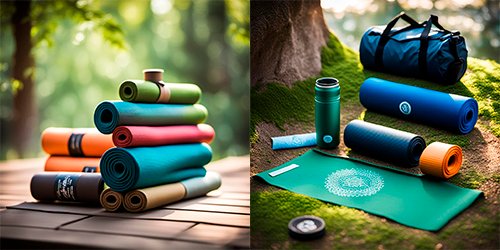“Decoding the Green Future: Trends, Innovations, and Original Eco-Friendly Gifts”
Introduction: In a world where sustainability has become an urgent necessity, discovering trends, innovations, and original eco-friendly gifts becomes essential. This article will not only immerse you in the latest developments but also guide you towards a greener and more conscious future. Join us on this journey towards sustainability!
The terms “eco-friendly” and “sustainable” are often used interchangeably, but they have specific nuances that reflect different aspects of environmental responsibility. Here’s a brief description of each:
Eco-Friendly Products:
Eco-friendly products are designed to have minimal impact on the environment. This involves the use of renewable materials, reducing pollution during manufacturing, and using clean energy. They may also be biodegradable, meaning they decompose at the end of their lifespan without causing environmental harm.
Sustainable Products:
Sustainability goes beyond just environmental aspects and also encompasses social and economic aspects. Sustainable products seek to maintain a balance between economic development, social welfare, and environmental preservation. This involves not only considering natural resources but also ethics in the supply chain, social equity, and economic responsibility.
Characteristics of Sustainable Products:
Sustainable products, also known as eco-friendly or green products, are designed, manufactured, and used in a way that minimizes their negative impact on the environment, society, and economy throughout their lifecycle. These products aim to balance current needs with the planet’s capacity to sustain them in the future.
Some common characteristics of sustainable products include:
- Sustainable Materials: They use renewable and recyclable materials, reducing reliance on non-renewable resources and minimizing waste.
- Responsible Manufacturing Processes: Manufacturers adopt practices and processes that reduce pollution, greenhouse gas emissions, and energy consumption.
- Durability and Quality: They are designed to have a longer lifespan, reducing the need for frequent replacement and decreasing waste generation.
- Sustainable Packaging: They minimize packaging usage and prefer recyclable or biodegradable packaging materials.
- Energy Efficiency: They seek ways to reduce energy consumption during production, use, and disposal.
- Certifications and Eco-labels: Sustainable products often carry certifications or labels indicating compliance with specific sustainability standards.
- Social Responsibility: They consider labor conditions and social impacts in the supply chain, ensuring ethical and fair practices.
Trends in Sustainable Products: Navigating the Green Waves of Consumption
The quest for sustainable products has sparked a revolution in how we consume. From the popularity of biodegradable packaging to the growing demand for eco-friendly beauty products, the market is evolving. But what are the trends that will set the pace for sustainable consumption?
Eco-Friendly Innovations: Science and Sustainability in Perfect Harmony
Science is leading the charge towards a greener future. From innovative materials to renewable energy technologies, eco-friendly innovations are transforming the way we live. Let’s explore the latest scientific research behind these innovations.
What Are Eco-Friendly Innovations?
Eco-friendly innovations refer to new developments, technologies, products, or processes that seek to minimize their environmental impact and promote sustainable practices. These innovations aim to address environmental and social challenges by offering creative and environmentally friendly solutions. Here are some examples of eco-friendly innovations:
- Sustainable Materials: Development of new materials that are renewable, biodegradable, or recyclable, reducing dependence on non-renewable resources.
- Renewable Energy Technologies: Advances in solar, wind, hydroelectric, and other forms of renewable energy to reduce reliance on fossil fuels and decrease greenhouse gas emissions.
- Eco-Friendly Packaging: Design of sustainable packaging, such as compostable, biodegradable, or recycled materials to reduce waste generation.
- Sustainable Fashion: Innovations in the fashion industry, such as organic fabrics, textile recycling, and ethical and transparent production practices.
- Sustainable Mobility: Development of electric vehicles, electric bicycles, and more efficient and environmentally friendly public transportation systems.
- Sustainable Agriculture: Implementation of environmentally friendly agricultural techniques, such as regenerative agriculture and practices that reduce the use of pesticides and chemical fertilizers.
- Green Architecture: Design and construction of sustainable buildings with energy-efficient technologies, eco-friendly materials, and environmentally focused design approaches.
- Advanced Recycling Technologies: Development of more efficient processes and technologies for recycling materials, including those historically difficult to recycle.
- Sustainable Food Production: Innovations in food production, such as vertical farming, lab-grown foods, and agricultural practices that reduce carbon footprint.
- Waste Management Technologies: Development of solutions for efficient and sustainable waste management, such as waste-to-energy conversion or creating products from recycled waste.
Original Eco-Friendly Gifts: Surprise with a Sustainable Touch
- Eco-Friendly Personal Care Products Set:
Includes personal care products such as solid shampoo, natural soaps, and bamboo toothbrushes.
- Reusable and Personalized Water Bottles:
Stainless steel or glass water bottles with custom designs and eco-friendly features.
- Urban Garden Kit:
Provides the opportunity to grow herbs or small vegetables at home, promoting connection with nature.
- Sustainable and Fair Trade Clothing:
Opt for clothing made from organic materials and fair trade practices.

- Recycled Educational Toys:
Creative toys made from recycled materials for young children.
- Sustainable Experiences:
Gift experiences like cooking classes with local ingredients, bike rides, or outdoor activities.
- Bamboo Travel Cutlery Set:
Portable bamboo cutlery to reduce the use of disposable plastic utensils.
- Native Bees in a Box:
Contribute to pollination by gifting a box with seeds and materials to create a habitat for native bees.
- Eco-Friendly Cleaning Products:
Cleaning kits with sustainable products, such as coconut cleaning brushes and eco-friendly detergents.
- Reusable Shopping Bags with Creative Designs:
Foldable and reusable bags with fun prints or inspiring messages.
- Ethical and Sustainable Jewelry:
Jewelry made from recycled materials or sourced from ethical origins.
- Sustainable Yoga Kit:
Yoga mats and accessories made from eco-friendly and sustainable materials.
- Eco-Office Kit:
Includes recycled office items such as notepads, sustainable pens, and desktop organizers.
- Subscriptions to Sustainable Products:
Gift subscriptions to services delivering monthly eco-friendly products, such as organic snacks or personal care items.
- Books on Sustainability and Ecology:
A selection of inspiring books educating about the importance of sustainability.
Statistics Revealing the Impact: Data Speaking for the Planet
- Waste Reduction:
According to the United Nations Environment Programme (UNEP), global plastic production reached 368 million tons in 2019. The adoption of sustainable products, such as biodegradable and reusable packaging, can significantly contribute to reducing this figure.
- Energy Savings:
A study by the World Resources Institute reveals that implementing energy efficiency technologies in products and processes could reduce greenhouse gas emissions by approximately 25%.
- Impact on Sustainable Fashion:
According to the Global Fashion Agenda organization, it is estimated that the fashion industry is responsible for 10% of global carbon emissions and uses more water than all citizens of the planet combined. Adopting sustainable fashion can significantly reduce this impact.
- Water Efficiency in Agriculture:
Sustainable Agriculture, which employs practices such as efficient irrigation and crop rotation, can reduce water consumption compared to conventional methods. According to the FAO, sustainable agriculture can improve water use efficiency by up to 30%.
- Recycling and Circular Economy:
According to the Ellen MacArthur Foundation, transitioning to a circular economy could generate economic benefits of up to $2.7 trillion annually by 2030. This includes boosting new job opportunities and reducing dependence on non-renewable resources.
- Biodiversity and Conservation:
The International Union for Conservation of Nature (IUCN) reports that sustainable agricultural practices and responsible forest management can help conserve biodiversity and reduce the loss of natural habitats.
- Carbon Emissions Reduction:
The International Energy Agency highlights that transitioning to more sustainable technologies and practices could reduce global carbon emissions by over 5 gigatons by 2050.
- Growth of the Sustainable Products Market:
According to Nielsen, sales of sustainable consumer products grew 20% faster than the rest of the market in 2019, demonstrating a growing demand and appreciation for sustainability among consumers.











